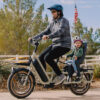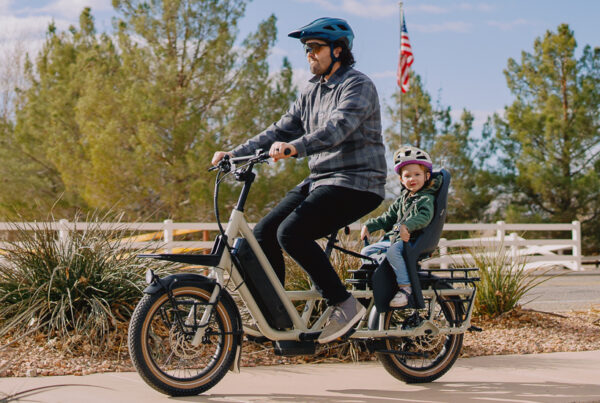Denago did a good job designing the “cockpit” of this bike, that is, the area where you sit and exercise most controls on the bike. I was able to set the stem, seat rail and seat post quickly and easily to size the bike to my body’s dimensions. Reaching my thumb to change gears, adjust PAS levels and activate the throttle were like second nature.
The Denago Fat Tire Bike is designed to ride in a more aggressive posture than some of the other fat bikes. I found myself leaning forward most often when riding this bike. This was probably a good thing when you consider this bike goes fast, and maneuvering this bike requires constant attention and adjustment to control.
Normally on a fat bike like this, I would prefer a 720mm handlebar, or longer, but the 700mm worked great maneuvering the bike around the pedestrians and slow riders I encountered, and felt like the right size. The PAS buttons were simple to actuate, the throttle positioned well to comfortably make comfortable adjustments, and the brake levers were conducive to my style of two-finger braking. The stock grips fit in my hands really well and are made of a solid rubber that appears to withstand sun, wet and cold.
The saddle was not comfortable for extended rides. This bike comes with a standard sport style seat, which is okay when you’re riding a bike that requires quite a bit of standing on the pedals, like on road bikes and mountain bikes. I raise this complaint often on most of the bikes I write about.
E-bike designers need to take a longer look at how much time they believe riders will be standing on their pegs, compared to sitting on their butts, when deciding on the seat padding (I’m not the only rider who is discriminant about comfort – I hear this a lot from other riders!). On the bright side, this bike’s seat at least includes a lift handle at the rear, making it easier to lift the bike onto a bike rack, or lift upstairs.
Zoom’s 879 front suspension forks help balance out the rougher riding sections, with its 80 mm of wheel travel and hydraulic lockout for added rigidity. The front and rear lights are integrated into the bikes electrical system, so you don’t need to worry about having extra batteries. The taillights are embedded into the rear seat stay of the frame, making it look cleaner, but also eliminating the nuisance of mounting it on the seat post, where it can often get banged up, slip loose, or break off. Additionally, adding to rider safety, the tail lights also flash as brake lights, letting the riders behind you know you’re braking, and reducing the risk of accidents.
Source link








